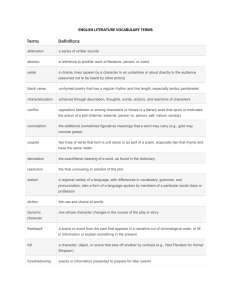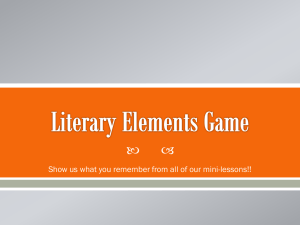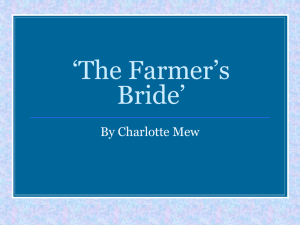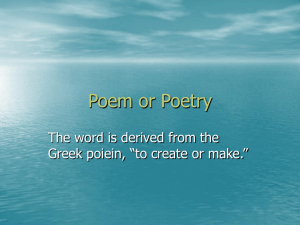Literary Terms
advertisement
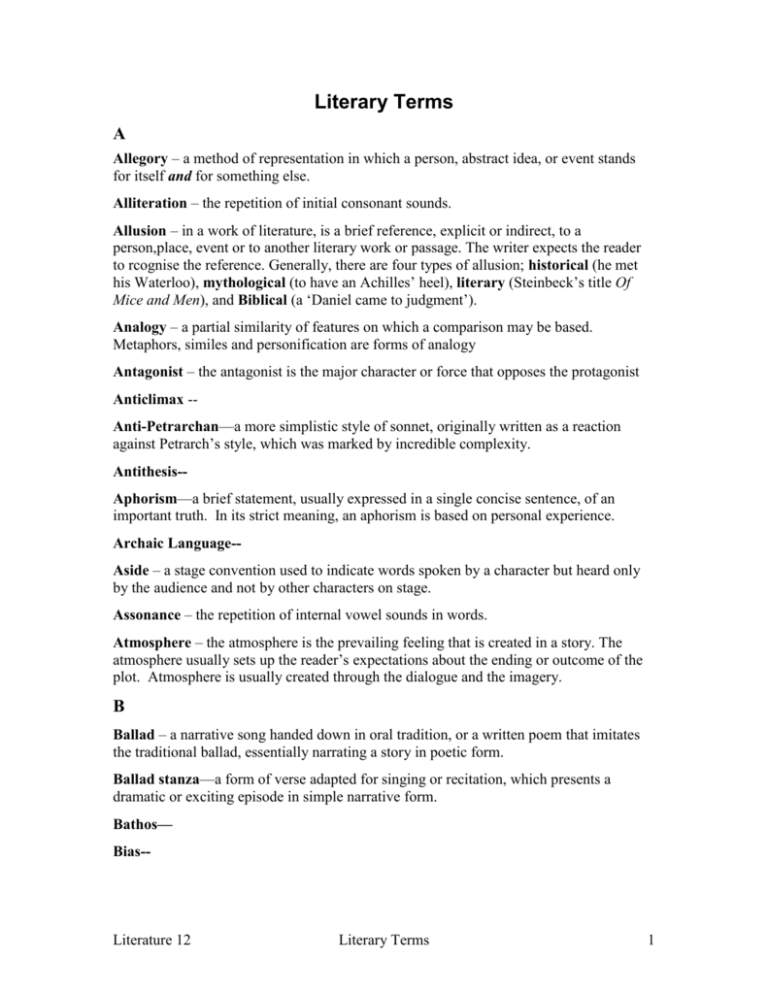
Literary Terms A Allegory – a method of representation in which a person, abstract idea, or event stands for itself and for something else. Alliteration – the repetition of initial consonant sounds. Allusion – in a work of literature, is a brief reference, explicit or indirect, to a person,place, event or to another literary work or passage. The writer expects the reader to rcognise the reference. Generally, there are four types of allusion; historical (he met his Waterloo), mythological (to have an Achilles’ heel), literary (Steinbeck’s title Of Mice and Men), and Biblical (a ‘Daniel came to judgment’). Analogy – a partial similarity of features on which a comparison may be based. Metaphors, similes and personification are forms of analogy Antagonist – the antagonist is the major character or force that opposes the protagonist Anticlimax -Anti-Petrarchan—a more simplistic style of sonnet, originally written as a reaction against Petrarch’s style, which was marked by incredible complexity. Antithesis-Aphorism—a brief statement, usually expressed in a single concise sentence, of an important truth. In its strict meaning, an aphorism is based on personal experience. Archaic Language-Aside – a stage convention used to indicate words spoken by a character but heard only by the audience and not by other characters on stage. Assonance – the repetition of internal vowel sounds in words. Atmosphere – the atmosphere is the prevailing feeling that is created in a story. The atmosphere usually sets up the reader’s expectations about the ending or outcome of the plot. Atmosphere is usually created through the dialogue and the imagery. B Ballad – a narrative song handed down in oral tradition, or a written poem that imitates the traditional ballad, essentially narrating a story in poetic form. Ballad stanza—a form of verse adapted for singing or recitation, which presents a dramatic or exciting episode in simple narrative form. Bathos— Bias-- Literature 12 Literary Terms 1 Blank Verse – poetry that lacks rhyme but has a very specific meter or rhythm called iambic pentameter. It has a special name because it is the principal English meter, including the tragedies of Shakespeare. C Cacophany Caesura—a pause or break in the metrical or rhythmical progress of a line of verse. Caricature—descriptive writing that seizes upon certain individual qualities of a person and, through exaggeration or distortion, produces a burlesque, ridiculous effect. Carpe Diem Character Character Foil Characterization Chorus – a group of singers and dancers who participate in dramatic performances and comment on the deeds of characters and interpret the significance of events for the audience. Classical Climax—a Colloquial Language Comedy—a form of drama that is intended to amuse and that ends happily. Comic Relief Conceit—striking, strained or affected modes of expression. Conflict – the struggle that grows out of the interplay of two opposing forces in a plot. Connotation – the emotional suggestions attached to words beyond their strict definition. Consonance – the repetitions of internal consonant sounds in words. Couplet – two lines, one following the other, which rhyme. D Denotation – the dictionary meaning of words. Denouement Dialect – a form of speech characteristic of a particular geographic region, social class, or a people. Dialogue Diary— Literature 12 Literary Terms 2 Diction – a style of speaking or writing resulting from a deliberate choice and arrangement of words in a story. Each writer uses diction appropriate to his or her purpose, subject, story type, characters, and style. Didactic Dilemma Dissonance – a harsh, disagreeable combination of sounds. Dramatic Irony Dramatic Monologue – a poetic form in which a single character, specking to a silent listener at a critical moment, reveals both a dramatic situation and his/her own character. E Elegy – a mournful, melancholy poem, especially a song of lament for the dead. English sonnet—(Shakespearean) a lyric poem of fourteen lines. Rhyme scheme is: abab cdcd efef gg Epic – a lengthy, narrative poem in which action, characters and language are on a heroic level and style is exalted and even majestic. Epigram – a witty, ingenious and pointed saying that is expressed tersely. Epigraph—(1) an inscription on a monument, building or statue or coin. (2) A motto or quotation appearing at the beginning of a written work or at the beginning of a section of work Epilogue Epitaph Essay—a Euphemism Euphony Exposition Extended Metaphor F Figurative Language – language used in such a way as to force words out of their literal meanings and, by emphasising their connotations, to bring new insight and feeling to the subject desired. (i.e. figures of speech, such as simile, metaphor and personification). Foreshadowing Free Verse Literature 12 Literary Terms 3 Foil—a character whose behavior and qualities set off or enhance by contrast those of another character Foreshadowing – gives a hint of what is to happen later in the story. It prepares the reader for the climax, the resolution and for changes, or lack of changes, in character’s attitudes. Form—an indication of events that are to come. Free Verse – verse that lacks regular meter and line length but relies upon natural rhythms. Free verse is “free” from fixed metrical patterns, but does reveal the cadences that result from alternation of stressed and unstressed syllables. G Genre—a type or category into which literary works can be grouped according to form, technique or purpose. H Heroic couplet—Iambic pentameter lines rhymed in pairs. Hyperbole – this is exaggeration in the service of truth. This is also called an overstatement. If you say, “I’m starved” you do not literally expect to be believed; you are merely adding emphasis to what you really mean. I Iambic pentameter—an iambus (Iamb) is a metrical foot consisting of an unaccented syllable and an accented syllable. Image—an image is a literal and concrete representation of a sensory experience or of an object that can be known by one or more of the senses. Imagery – language which appeals to the senses and creates a mental image. It is something seen in the “mind’s eye”. Visual imagery is the most common, but an image may also represent a sound, a smell, a taste or a tactile experience, such as cold, hunger, etc. In media res—“in the middle of things.” Internal Rhyme – rhyme which comes within lines. Inversion—changing the normal word order in a sentence to gain emphasis or effect Invocation—an address appealing to a diety or muse for aid. Irony – a literary device which reveals concealed or contradictory meaning. There are three forms: a) Dramatic Irony – this irony occurs when the author shares with the reader information not know by a character. As a result, the reader becomes aware that a character’s actions may be inappropriate for the actual circumstances, that what is to Literature 12 Literary Terms 4 come is the reverse of what a character expect, or that a character has unknowingly made a comment which anticipates the outcome. b) Irony of Situation or Situational Irony – this occurs when a set of circumstances turn out differently from what was expected or considered appropriate. c) Verbal Irony – this occurs when a contrast is evident between what a character says and what that character actually means. Usually the opposite is stated for emphasis. See also sarcasm, which is not quite the same. Italian sonnet—(Petrarchan) a lyric poem of fourteen lines. Rhyme scheme abba abba cde cde (or cd cd cd) K Kenning—a figurative phrase used in Old English or other Germanic languages as a synonym for a simple noun. L Latinate Literal Language Lyric – any short poem intended mainly to express a state of mind or feeling. M Metaphor – a comparison between two things which are essentially dissimilar. The comparison is implied rather than directly stated. Metaphysical—the poetry of John Donne and other 17th century poets who wrote in a similar style. Characterized by verbal wit, excess, ingenious structure, irregular meter, colloquial language, elaborate imagery and drawing together of dissimilar ideas. Meter - any regular pattern of rhythm. Shakespeare wrote in iambic pentameter. Metonymy – use of a closely related idea for the idea itself. “ The kettle is boiling” – really means the water in the kettle boils, not the kettle itself. “The pen is mightier that the sword” meaning words are more powerful than violence and also “the bottle” may refer to strong drink. Mock epic—a literary form that burlesques epic poetry by treating a trivial subject in a pompous manner. Monologue Mood – see Atmosphere. Motif— Literature 12 Literary Terms 5 N Narrative – this is another word for story. Narratives have the following elements: plot, conflict, characters, setting, point of view and theme. Narratives may be fictional or nonfictional, and include novels and (auto)biographies as well as short stories and anecdotes. Narrator—chief interpreter and reporter of a story’s events. Near Rhyme (half, slant) O Octave – an eight line stanza or the first eight lines in an Italian or Petrarchan sonnet. Ode – a form of lyric poem with a dignified theme that is phrased in a formal, elevated style and is usually a statement of praise for someone. Onomatopoeia – the use of words which sound like what they mean. Sizzle sounds like bacon in a frying pan. Oxymoron – two words placed close together that are contradictory yet have truth in them i.e. Jumbo Shrimp, pretty awful. P Paradox – this is a statement in which there is an apparent contradiction which is actually true. Parallelism—(also known as parallel structure) In writing, an arrangement of phrases, sentences and paragraphs so that elements of equal importance are equally developed and similarly phrased. Parody – a literary work that imitates the characteristic style of an author or work for comic effect or ridicule; a humorous, satirical or off-beat imitation or a person, event or serious work of literature. Pastoral—a poem concerned with rustic life. Pathos-Pentameter – a line of five metrical feet. Pentameter, from Greek words meaning ‘five’ and ‘measure’, is more widely used in poetry in English than any other length of line. Persona – a mask or identity a writer adopts and presents as the suggested speaker in a particular work. Personification – giving the attributes of a human being to an animal, an object or an idea. It is really a subtype of metaphor, implying a comparison between two dissimilar things. Petrarchan (Italian) sonnet—a lyric poem of fourteen lines. Rhyme scheme abba abba cde cde (or cd cd cd) Play on Words Literature 12 Literary Terms 6 Point of View – as applied to fiction, this term describes the vantage points from which the author relates the story. There are four points of view: a) First Person – features the protagonist telling his or her own story directly to the reader using the first person (I, me my, we, us, our) pronouns. This point of view tells us what the main character thinks and feels from a vantage point ‘inside’ the story and the protagonist him or herself. b) Objective – the narrator is similar to a television camera in that he/she only reports what is seen and heard without entering the minds of characters or presenting the author’s ideas and observations. c) Omniscient – this narrator reveals the minds of several or all characters, knowing and telling all from an all-seeing, God-like perspective ‘outside’ the story. d) Limited Omniscient – this refers to the main character as ‘he’ or ‘she’ and shows us only what one character thinks and feels, but from the perspective of someone ‘outside’ the story. Protagonist – The main character in a story. While some protagonists may be heroes or heroines, more typically they are like people we meet in real life: they have a mixture of characteristics, some of which may be weaknesses. Proverb Pun – this is a play on words in which a word or phrase can be taken to mean more than one thing. Q Quatrain – a stanza of four lines. The quatrain in the most common stanzaic form of poetry written in English. Shakespearean sonnets contain three quatrains and a couplet. R Refrain – a line, or part of a line, or a group of lines which is repeated in the course of a poem, sometimes with slight changes, and usually at the end of each stanza. Resolution Rhetoric Rhetorical Question Rhyme – similarity of sound in words. Two words rhyme when their accented vowels and all succeeding sounds are identical. Rhyme Scheme – any pattern of rhymes in poetry. Each new sound is assigned the next letter in the alphabet. The rhyme scheme for a Shakespearean sonnet is abab cdcd efef gg. Literature 12 Literary Terms 7 Rhythm – a series of stressed or accented syllables in a group of words, arranged so that the reader expects a similar series to follow. Romanticism—a movement of the 18th and 19th centuries that marked the reaction in art, religion and politics against the neoclasicism and formal doctrines of the preceding period. S Satire – the ridicule of an idea, person, or type sometimes in order to provoke change. Satire usually mocks human vices or foibles. Sestet – the last six lines of an Italian sonnet; any stanza of six lines. Setting – setting is most often considered to mean the time and place in which a story is placed; however, equally important aspects are the social environment or values generally shared by the society, the minor characters who form a realistic backdrop with which the main characters must act and react. Finally, setting also includes atmosphere or mood which descriptive details create. Shakespearean (English) sonnet—a lyric poem of fourteen lines. Rhyme scheme is: abab cdcd efef gg Simile – a comparison between two things which are essentially dissimilar. The comparison is directly stated through words such as like, as, than, similar to or resembles. Soliloquy – the utterance of a character who is talking to himself or herself and who is unaware of any hearers who may be present. It is used in drama to allow the audience insight into a character’s innermost feeling or to give the audience essential information. Sonnet – a fourteen-line poem following a strict rhyme scheme and meter. The Shakespearean sonnet was rhymed abab cdcd efef gg and used iambic pentameter. The Italian or Petrarchan sonnet was rhymed. Speaker—central voice in a story or poem. Spenserian stanza—a stanzaic pattern of nine verses, the first eight in iambic pentameter, the nine in iambic hexameter. Rhyme scheme is ababbcbcc Stanza – Essentially a unit of lines in a poem, identifiable by spacing. Stock (Stereotyped) Style – Style is the individual manner in which an author expresses his or her thoughts and feelings. In fiction, style is basically determined by such grammatical and sensory aspects as diction, sentences and images. Some stylistic devices are repetition, rhetorical questions, descriptive language, parallel construction, exaggeration, sentence fragments and dialogue. Symbol – a symbol has two levels of meaning, a literal level and a figurative level. Characters, objects, events and settings can all by symbolic in that they represent something else beyond themselves. The dove literally is a bird, but it has come to figuratively represent peace. (symbolism) Literature 12 Literary Terms 8 Synecdoche – the use of the part for the whole idea. “All hands on deck” really would mean all people on the ship, to the deck, not just their hands. The ‘Hippocratic eye’ is really a doctor; ‘paleface’ is a white person. Syntax—function of a word, phrase or clause within a sentence T Tercet—a stanza of three rhyming lines. Also used to denote either one of the two threeline groups forming the sestet of the Italian sonnet. Terza rima—a three-line stanza form borrowed from the Italian poets. Rhyme scheme aba bcb cdc ded et cetera Tetrameter—a line of verse consisting of four feet. Theme – the central idea of a story, usually implied rather than directly stated. It is the author’s idea about life and can be implied or directly stated through the voice of a character or through the narrator. It should not be confused with moral or plot. A theme is traditionally stated in a sentence without reference to specific characters or events. Tone – tone is the author’s attitude toward his/her subject or readers. It is similar to tone of voice and should not be confused with mood or atmosphere. An author’s tone might be sarcastic, sincere, apologetic, humorous, bitter, analytic, reflective, nostalgic, resigned, didactic, etc. Tragedy – this is a drama that gives the audience an experience of catharsis or cleansing of emotions. The protagonist, a person of nobility, must make a moral decision that in turn influences the outcome of the drama. The protagonist usually has a serious fault, the tragic flaw, that leads to his/her downfall and death. The terror and pity felt by the audience produce catharsis, a cleansing or purifying of emotion. Trochaic Trochee Trimeter V Villanelle—a French verse form composed of 19 lines divided into five tercets and a final four-line stanza. Rhyme scheme aba aba aba aba aba abaa Voice—chief interpreter and reporter of a story’s events. Volta—in a sonnet, the change in thought that separates the first eight lines from the last six lines. W Wit— Word Play Literature 12 Literary Terms 9 Literature 12 Literary Terms 10


